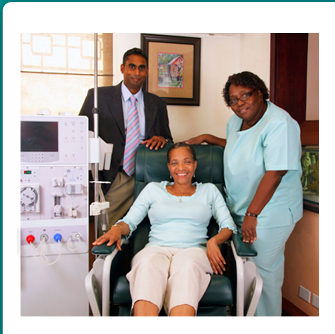5:00AM - 4:00PM
Monday to Saturday

The strained dialysis unit at the Queen Elizabeth Hospital has been seeing an increase in Barbadians with renal failure, forcing it to treat up to 120 patients in a facility which can only cater to a maximum of 84.
However, thanks to the Rotary Club of Barbados, a new Renal Dialysis Unit will be constructed at the hospital to the tune of $400,000. It will feature 20 dialysis machines, an additional six, to complement the 14 currently in use.
Consultant nephrologist at the hospital, Emile Mohammed said the increase in end-stage renal failure was due to the prevalence of obesity and chronic non-communicable diseases such as diabetes and hypertension. He said the new unit, which should be completed by mid-October, was needed urgently, and the additional dialysis machines would ensure patient care was not compromised.
“We are now at the fall-out period where we are seeing a lot of end-stage renal failure. What’s disconcerting, is that it has not hit a steady stage yet, so we don’t know where it is going to plateau off.
“In our old dialysis unit, we have a maximum capacity of 84 patients. At present, we dialyse up to 120 patients, so you can understand the need for this project, it is an absolute necessity. “We need to get it up and running as soon as possible because we have patients who need dialysis here and now,” the doctor said during a tour of the soon-to-be renovated space located on the ground floor of the hospital.
The tour party also included Rotary District Governor Victor Pilgrim; Donville Inniss, president of Rotary West; Joe Steinbok, assistant governor and chairman of the Paediatric Ward Project; and Peter Griffith, past president and chairman of the Renal Dialysis Renovation Project.
Renal care in Barbados has gone “state of the art”. And improvement will save the Queen Elizabeth Hospital (QEH) $3 million over the next year. With the incidence of non-communicable diseases still on the rise, the RENAL CARE IN BARBADOS has gone “state of the art”. And improvement will save the Queen Elizabeth Hospital (QEH) $3 million over the next year.
With the incidence of non-communicable diseases still on the rise, the new Artificial Kidney Unit which was opened yesterday at the QEH is a welcomed relief. While opening the almost $1 million unit yesterday, Minister of Health, Jerome Walcott underscored the importance of the high-tech facility, which was significantly funded by the Rotary Club of Barbados West, and will help more than 150 Barbadians deal with chronic kidney problems.
The facility is “comparable to any in the developed world” and has increased the number of dialysis units to 24 from 14, making critical care more available to those who need it. Walcott said that Barbados was continually working to improve the quality of heath care, noting that “some islands in the Eastern Caribbean have no dialysis unit”.
“Barbados is in the midst of an epidemic of non-communicable diseases. Chronic kidney failure is a result of these diseases, such as diabetes and high blood pressure,” said Dr Emile Mohammed, nephrologist.
Dr. Emile Mohammed, Consultant nephrologist and head of the nephrology services, making a point with Margaret O’Shea, Consultant General and Kidney Transplant Surgeon at the press conference.
DOCTORS at the Queen Elizabeth Hospital (QEH) have transplanted a kidney from a healthy 58-year-old man to his 28-year-old son. The “operation” was done on May 14, and was the first “living related kidney transplant” conducted at the QEH in ten years.
Yesterday, at a Press conference at the QEH board room, Dr Emile Mohammed, consultant nephrologist and head of the nephrology services, said the son was a kidney failure patient and on dialysis for over eight years.
He said the operation had gone extremely well and both the son and the father were already home.
“I think the operation going well is a testament to the very meticulous preparation of both the father and the son, the surgical expertise and the meticulous and detailed care they received after the operation,” he said.
He noted that what was very reassuring was that the expertise involved in doing the transplant, was largely employees of the QEH.
The idea that beautiful and functional everyday objects should not only be affordable to the wealthy, but to all, is a core theme in the development of modernism and functionalism. This is probably most completely realized in post-WWII Scandinavian design. The ideological background was the emergence of a particular Scandinavian form of social democracy in the 1950s, as well as the increased availability of new low-cost materials and methods for mass production. Scandinavian design often makes use of form-pressed wood, plastics, anodized or enameled aluminum
or pressed steel.
Barbados is not only known for its idyllic beaches lapped by crystal clear waters and year round near perfect weather, but also for its good infrastructure with excellent health care facilities.
Read More